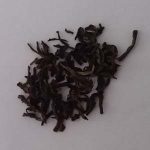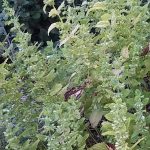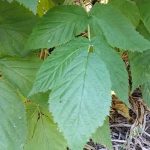Tea has been a favorite beverage of many cultures for centuries. Drunk originally in China for medicinal purposes it is now mainly drunk to get a ‘lift’. But there are now dozens of different teas from many plant sources and all come in different types of packaging, loose, in cans or boxes or in little bags. We can also grow teas at home – even in Australia. These different methods of obtaining tea differ in their sustainability and maybe grow-your-own is best.
he early 1600s. Its use then spread to France, Germany and Great Britain in the mid-1600s. Initially only drunk by the wealthy because it was expensive, it became more widely used when more was imported and the price fell to the point where it could be regarded as a typically British beverage2.
Growing Tea
Most tea production has been in humid areas with rich, acid soil and high rainfall. It grows well in tropical and sub-tropical climates with partial shade, but in other areas it needs full sun as long as it receive sufficient water. Pesticides are used in many tea-growing areas3, but their levels are reduced in the final products if the tea leaves have been washed during processing.
 In Australia, tea is grown in many regions from north Queensland through to Victoria and Tasmania4,5. It has an advantage that it does not need pesticides because Australia’s quarantine regulations have prevented pest entry.
In Australia, tea is grown in many regions from north Queensland through to Victoria and Tasmania4,5. It has an advantage that it does not need pesticides because Australia’s quarantine regulations have prevented pest entry.
Nerada in far north Queensland is perhaps the oldest tea company – the Cutten family commenced growing tea in 18866.
Unfortunately, cyclones and a tidal wave nearly destroyed the plantation. However, in 1958 Dr. Maruff started a commercial tea enterprise using the seeds and cuttings from the surviving original plantings and created the basis for the largest tea company in Australia. Its products are free of pesticides7.
There are now a number of other tea producers including Madura, Alpine, Two Rivers, Jemidee, Daintree and more.
How about growing your own?
There are a number of suppliers of tea plants grown from cuttings in Australia – seed-derived plants may not have the same properties as the parent. Plants can be grown in pots or as hedges since they withstand both leaf harvest and more aggressive hedge trimming. Pots have the advantage of being movable if the weather becomes too hot and dry or too cold. Soil should be enriched with compost and organic fertilizer and kept moist. It is a good idea to grow two or more plants so that you can harvest leaves from one while the other(s) keeps growing. Harvest should be possible after 2 – 4 years. For more detail click here.
As well as providing a tasty drink with a mild caffeine-hit, tea leaves can be used as a flavor enhancer in other foods and as a breath freshener.
Making the best brew
How to make the best cuppa varies with not only the type of process to make commercial products but also with water temperature, length of brewing time and whether milk is added. For advice click here and here.
Herbal Tea
 If you don’t like caffeine try herbal tea! And here is the real opportunity to grow your own if you want to have really fresh leaves, reduce your environmental impacts (no transport, pesticides or packaging) and cost and to provide bee forage! However, many are also commercially available.
If you don’t like caffeine try herbal tea! And here is the real opportunity to grow your own if you want to have really fresh leaves, reduce your environmental impacts (no transport, pesticides or packaging) and cost and to provide bee forage! However, many are also commercially available.
Most are easy to grow in pots or in the ground and the list is extremely long8. The most common ones are:
– Leaves: lemon balm, the mints, rosemary, raspberry, catnip, nettle, dandelion, lemon verbena, bee balm, thyme and coriander
– Flowers: elder, lavender, jasmine, chamomile.
– Roots: ginger
– Stalks: lemon grass
– Other: rose hips
– More for medicinal use: Horsetail, hyssop, motherwort, mugwort, Echinacea, yarrow, feverfew, calendula petals, fennel, sage.
 Use fresh or air dry. To maintain plants, use only a few leaves at a time. Because some of these grow very easily, they are regarded as weeds. So watch out for those with invasive roots e.g. nettle, mints, raspberry, which are best grown in pots. Also be careful with those that establish too easily from seed e.g. nettle and lemon balm, which should be pruned before the flowers set seed.
Use fresh or air dry. To maintain plants, use only a few leaves at a time. Because some of these grow very easily, they are regarded as weeds. So watch out for those with invasive roots e.g. nettle, mints, raspberry, which are best grown in pots. Also be careful with those that establish too easily from seed e.g. nettle and lemon balm, which should be pruned before the flowers set seed.
Native herbal teas
Even better, try tea from Australian native plants. Perhaps the easiest to grow are lemon myrtle Backhousia citriodora or aniseed myrtle Syzgium anisata. Although they are both rain forest trees they are very adaptable and don’t grow more than about 3 m in suburban settings. In summer they are covered with flowers which are attractive to bees, butterflies and nectar eating insects. Their leaves make teas tasting of lemon and aniseed respectively.
A number are commercially available e.g. lemon myrtle, wattle seed and blends incorporating peppermint gum leaves, rosella, wild hibiscus, lilli pilli, pepperberry and strawberry gum.
Tea Bags – Pros and cons
Tea quality
Making tea in a pot is not everyone’s cup of tea, so to speak. Tea bags are very convenient, they are easily transportable, allow for easy choice of strength of brew for individuals and don’t require fiddling with a tea pot.
However, the content of bags is variable. The tea is the “dust” that accumulates at the bottom of containers where tea leaves are dried. Although this dust is still tea, the fine particle size allows rapid release of flavours including unwanted bitterness so that the result may be less pleasant than tea brewed correctly from whole leaves. The content of different types of bag (rectangular, round, pyramid, sachets) may be primarily dust, whole leaves or fragments, depending on what works best with the shape9 and this variability means that the quality of tea flavor also varies.
Bag Composition
Unfortunately, there are potential risks associated with the material used to make some bags. They are normally made from paper or other cellulose products, such as from corn starch, but are frequently stabilised with various types of plastic e.g. rayon, PVC or polypropylene so that the paper does not fall apart in hot water10. It is likely that some of this plastic leaches out into your tea. Moreover, epichlorohydrin, a potential carcinogen, is added to the paper to increase its wet strength11 and can also leach out. And even the paper may have been bleached with chlorine.
Is the Bag Compostable?
There is some debate about whether tea bags should be added to compost systems because many contain microplastics, toxins or bleach. All of these substances can be broken down by soil organisms, but it is not known to what extent they will decompose in compost. If they are not fully broken down they may leach out and find their way into ground water and eventually streams. In Europe, microplastics are found in tap water and sea salt but it is not clear if they pose a significant risk to human health12. The contribution that tea bags make to this is pretty small though, given the large scale use of plastics elsewhere.
If you want to avoid adding these unwanted chemicals and plastics to compost, you should break tea bags open and only compost their content, throwing the outer material in the rubbish.
Our Recommendations
For a cuppa of conventional tea which is exquisite-tasting, healthy and has lower environmental impact use:
- Loose leaf tea made in a tea-pot using optimum water temperature and brewing time that has been grown organically.
- Use Australian grown – there is low or no pesticide contamination and environmental impacts of long distance transport are reduced.
- Grow some of your own if the climate is appropriate.
- If you must use tea bags, look for those that contain whole leaves and are made from wholly natural materials.
- If you want to avoid caffeine go for herbal teas – either loose leaf or in bags chosen according to the criteria mentioned above.
To minimize environmental impacts buy Australian!
And even better, grow your own!
References
- http://www.homelife.com.au/gardening/how-to-grow/growing-tea
- https://en.wikipedia.org/wiki/History_of_tea
- http://healthyhayles.com/home/what-is-actually-in-your-tea
- www.abc.net.au/news/2016-03-03/tasmanian-tea-farm-viable-rival-wine-industry/7216322
- https://en.wikipedia.org/wiki/Tea_in_Australia
- www.neradatea.com.au/our-story/philosophy
- https://www.growveg.com.au/guides/grow-your-own-fresh-herbal-teas/
- https://ratetea.com/topic/loose-tea-bags-sachets-compressed-blooming/18/
- http://moralfibres.co.uk/is-there-plastic-in-your-tea/
- https://www.openpr.com/news/888703/Epichlorohydrin-Market-Size-Growth-Latest-Trend-Forecast-2023.html
- https://www.foodnavigator.com/Article/2017/09/13/Microplastics-found-in-food-and-water-Food-scare-or-perfectly-safe
Related Articles:
Garden Journaling – Slow down to tune in.
As we move through the year and our gardens evolve, there's something magical about documenting the journey. Garden journaling is an art that enables…
The Importance of building soil health for a biodeverse, productive garden
Creating a thriving garden that not only sustains itself but also contributes to the broader ecosystem requires more than just sunlight and water.…




